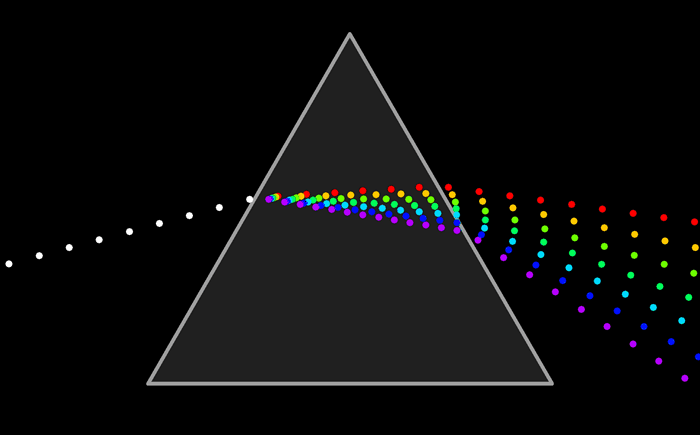ꯐꯥꯏꯜ:Light dispersion conceptual.gif
Light_dispersion_conceptual.gif (৭০০ × ৪৩৫ ꯄꯤꯛꯆꯦꯜꯁ, ꯐꯥꯏꯜ ꯆꯥꯎꯕꯒꯤ ꯆꯥꯡ: ১১৯ KB, MIME ꯃꯈꯜ: image/gif, looped, ৮ frames, ০.৮ s)
ꯐꯥꯏꯜꯒꯤ ꯄꯨꯋꯥꯔꯤ
ꯆꯩꯆꯠ/ꯃꯇꯝꯗ ꯅꯝꯃꯨ ꯃꯇꯝ ꯑꯗꯨꯗ ꯐꯥꯏꯜ ꯑꯗꯨ ꯎꯅꯕ
| ꯆꯩꯆꯠ/ꯃꯇꯝ | ꯈꯨꯠꯄꯤꯈꯨꯖꯤꯟ | ꯄꯥꯛ ꯆꯥꯎꯕꯥ | ꯁꯤꯖꯤꯟꯅꯔꯤꯕ | ꯑꯄꯥꯝꯕ ꯐꯣꯡꯗꯣꯛ ꯎ | |
|---|---|---|---|---|---|
| ꯍꯧꯖꯤꯛꯀꯤ | ꯲꯲:꯵꯸, ꯲꯴ ꯐꯦꯕꯨꯋꯥꯔꯤ ꯲꯰꯰꯷ |  | ৭০০ × ৪৩৫ (১১৯ KB) | LucasVB | Changing "white photons" back to the same size as the colored ones. |
| ꯲꯳:꯰꯲, ꯱ ꯐꯦꯕꯨꯋꯥꯔꯤ ꯲꯰꯰꯷ |  | ৭৫০ × ৪৯৮ (১১৭ KB) | Leyo | Auf eine alte Version zurückgesetzt | |
| ꯱꯷:꯰꯹, ꯲꯳ ꯖꯥꯅꯨꯋꯥꯔꯤ ꯲꯰꯰꯷ |  | ৭৫০ × ৪৯৮ (১১৭ KB) | LucasVB | Larger "white" photons may give a better idea of "division of white light". Also, removed magenta color since it is not a spectral color (I don't know why I didn't do this earlier) | |
| ꯲꯲:꯲꯴, ꯲꯱ ꯖꯥꯅꯨꯋꯥꯔꯤ ꯲꯰꯰꯷ |  | ৭০০ × ৪৩৫ (১২১ KB) | LucasVB | Once again, larger (700px), but now a constant stream of "photons", per request. The file is actually smaller now because we just need 8 frames. | |
| ꯱꯰:꯳꯱, ꯲꯱ ꯖꯥꯅꯨꯋꯥꯔꯤ ꯲꯰꯰꯷ |  | ৪৫০ × ২৯৬ (৩৭৯ KB) | LucasVB | Larger size. | |
| ꯰꯲:꯲꯲, ꯲꯱ ꯖꯥꯅꯨꯋꯥꯔꯤ ꯲꯰꯰꯷ |  | ২৫০ × ১৬৭ (২৬৫ KB) | LucasVB | Conceptual animation of w:dispersion of light. |
ꯐꯥꯏꯜꯒꯤ ꯁꯤꯖꯤꯟꯅꯐꯝ
ꯃꯇꯨꯡ ꯏꯟꯕ ꯂꯃꯥꯏꯁꯤꯖꯤꯟꯅꯕ ꯃꯁꯤꯒꯤ ꯐꯥꯏꯜ:
ꯃꯥꯂꯦꯝꯒꯤ ꯊꯥꯛꯇꯥ ꯁꯤꯖꯤꯟꯅꯕꯥ ꯐꯥꯏꯜ
ꯃꯁꯤꯒꯤ ꯐꯥꯏꯜ ꯑꯁꯤ ꯃꯈꯥꯒꯤ ꯑꯇꯩ ꯋꯤꯀꯤꯁꯤꯡꯅ ꯁꯤꯖꯤꯟꯅꯩ:
- ar.wikipedia.org ꯗꯥ ꯁꯤꯖꯤꯟꯅꯩ
- الكندي
- ضوء
- انكسار (فيزياء)
- غاليليو غاليلي
- تجربة ميكلسون ومورلي
- ازدواجية موجة جسيم
- بوابة:الفيزياء
- ضوء متباطيء
- مقراب
- فوتون
- ليزر
- طيف كهرومغناطيسي
- تجربة الشق المزدوج
- أثر بوكل
- ظاهرة كير
- لون
- موجة كهرومغناطيسية
- إسحاق نيوتن
- قوس قزح
- تدوير ضوئي
- مقياس استقطاب
- منشور نيكول
- علاقة كراميرس-كرونيج
- دليل موجة
- طول الموجة
- نظارة
- تشتت (بصريات)
- جيمس كليرك ماكسويل
- تأثير دوبلر
- ألبرت ميكلسون
- سرعة الضوء
- رينيه ديكارت
- نظارة طبية
- عدسات لاصقة
- ليف بصري
- المناظر
- بصريات
- هنري بيكريل
- بوابة:الفيزياء/بوابات شقيقة
- ظاهرة كهروضوئية
- تخزين بيانات بصرية ثلاثية الأبعاد
- عدسة (بصريات)
- سراب
- قانون بير-لامبرت
- مطيافية
- آندرز أنغستروم
- قنديلة
- لويس دي بروي
- استقطاب (فيزياء)
- إرنست كارل آبي
ꯌꯦꯡꯉꯨ ꯃꯂꯦꯝꯒꯤ ꯊꯥꯛꯀꯤ ꯁꯤꯖꯤꯟꯅꯐꯝ ꯑꯗꯨ ꯃꯁꯤꯒꯤ ꯐꯥꯏꯜꯁꯤꯗ ꯫
